TWO RADICALLY DIVERSE MUSEUMS TO DISCOVER IN ROME
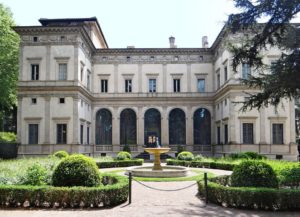
For those of us who have been to Rome numerous times and have seen all or most of the city’s major monuments and museums, it’s great to come across two lesser-known attractions. These two museums are complete opposites to each other: one being a small, very fine Renaissance villa set in a beautiful garden, while the other is Rome’s newest gallery of contemporary art and architecture, housed in a former automobile factory with a dramatic extension by the late Zaha Hadid, one of the 21st century’s most gifted architects.
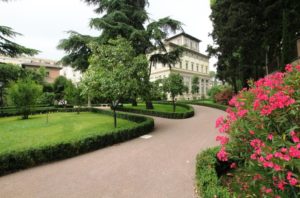
The Villa Farnesina is a Renaissance palazzo in the Via della Lungara in the Trastevere district, and is one of the most majestic buildings that remain from that period in Rome. It was built between 1506 and 1510 to a design by Baldassare Peruzzi, an architect, painter, and theatrical designer from Siena, as a pleasure palace and holiday home for the fabulously wealthy papal banker, Agostino Chigi, also from Siena. Not only a highly successful banker, Chigi’s wealth also came from alum mines near Rome, for which he held a monopoly, shipping this valuable mineral salt internationally with his own fleet, anchored at Porto Ercole.
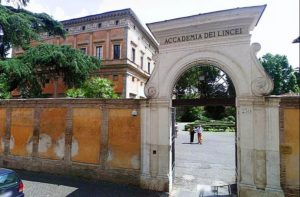
The Villa’s design was quite different from that of a typical urban palazzo. Renaissance palaces typically faced onto a street and were generally decorated versions of defensive castles, i.e., rectangular blocks with rustic-looking ground floors and enclosing a courtyard. Instead, this villa was intended to be an airy summer pavilion, and had one side towards the street, and a U-shaped plan with a five-bay loggia between its “arms”. In the original plan, the main entrance was through the north facing loggia, which was open. Today, visitors enter on the opposite, southern, side, and the loggia is glazed. Peruzzi designed the villa to maximise shade in the summer rooms, and light in the winter rooms.
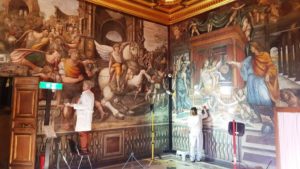
Treasurer to Pope Julius II, Chigi was one of Raphael’s principal patrons. He showcased his wealth by commissioning artists to paint elaborate frescoes on the walls and ceilings of his palace. The museum, therefore, is the Villa itself. These frescoes by Raphael, Bazzi (known as Sodoma), and other great Renaissance masters, as well as Peruzzi himself, are mostly mythical themes depicting gods and myths, and have been beautifully restored.
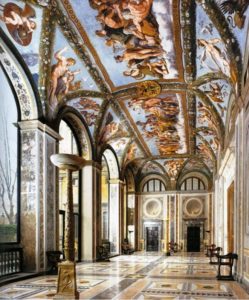
The themes of the frescoes were inspired by the verses of the poet Angelo Poliziano, an important member of the circle of Lorenzo de Medici. The best known of the frescoes are those by Raphael on the ground floor. In the loggia, he depicted the myths of Cupid and Psyche—thought to be chosen by Raphael to allude to the forthcoming wedding of his patron and his bride—and The Triumph of Galatea, one of Raphael’s most important works. This shows the near-naked nymph on a shell-shaped chariot amid frolicking attendants, and is reminiscent of Botticelli’s The Birth of Venus. Raphael also transformed the vault of the entrance loggia into a pergola, to appear as though the greenery of the gardens had invaded the Villa.
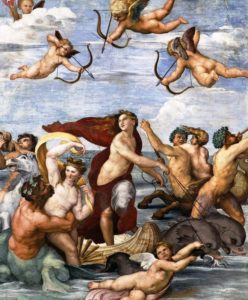
The “Galatea” loggia also has a horoscope vault that displays the positions of the planets around the zodiac on the patron’s birth date, 29 November 1466. Typical of other Renaissance patrons, Chigi decided to wait for a favourable alignment of the planets for the laying of the first stone, in this case 22 April 1506, which was thought to mark the anniversary of the founding of Rome.
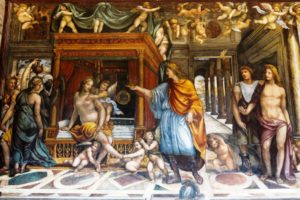
On the first floor, Peruzzi painted the main salon, the Sala delle Prospettive, with trompe-l’œil frescoes depicting a fictional city through the marble columns, with a view of the countryside beyond. In the adjoining bedroom, Sodoma painted scenes from the life of Alexander the Great, such as the marriage of Alexander and Roxanne.
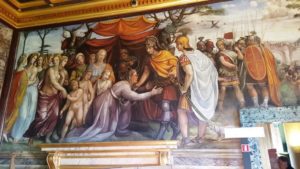
By bringing together the supreme mastery and compositional skills of Raphael and the other great masters, Chigi was able to amaze his frequent guests with the talents of the greatest artists of the age, and thus bestow lustre on the house of Chigi. The Villa is an important manifestation of the luxury and opulence that predominated in the highest levels in Italian society during the Renaissance period. Chigi lived in the Villa until his death in 1520. After Chigi’s death, his wayward heirs squandered the family fortune.
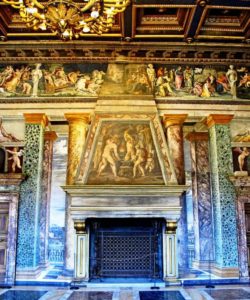
After a somewhat troubled history and many changes of ownership, the Villa now bears the name and preserves the memory of the Farnese family, who acquired it in 1577. Also in the 16th century, Michelangelo proposed linking the Palazzo Farnese on the other side of the river Tiber, where he was working, across to the Villa Farnesina, with a private bridge. This project is known to have started, as evidenced by the remnants of a few arches at the back of Palazzo Farnese near the via Giulia, but was never completed.
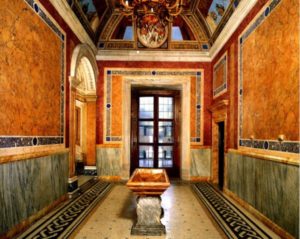
Later, the villa belonged to the Bourbons of Naples and in 1861 to the Spanish Ambassador in Rome. Today, it’s owned by the Italian State and accommodates the Academia dei Lincei, a long-standing and renowned academy of sciences in Rome. The main rooms, including the Loggia, are open to visitors. The Villa is not large, but it’s perfect for a relaxing morning visit, as a contrast to Rome’s often overwhelmingly enormous and crowded cultural treasures.

Located at 230 Via della Lungara, the long road that runs alongside the river, it’s easy to get to the Villa on foot. It’s less than 500m from the Campo de’ Fiori on the other side of the River Tiber, and buses run close by. Note that the Villa closes at 1.00pm on its open days, and is closed on Sundays, but do check the opening times beforehand. There isn’t an on-site café, but Trastevere is bursting with cafes, restaurants and bars.
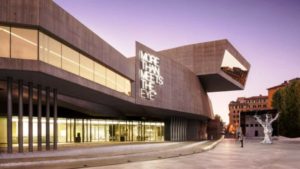
The MAXXI Museum is the National Museum of 21st Century Arts, and the first Italian national institution devoted to contemporary creativity. It’s managed by a Foundation under the umbrella of the Ministry for Cultural Heritage and Activities. Its program of activities covers exhibitions, workshops, conferences, shows, and educational projects. It’s also designed to reflect the museum as a place for the conservation and exhibition of its collections, but also, most importantly, as a laboratory for cultural experimentation and innovation and for the study, research and production of works and objects.
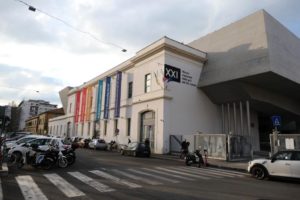
The museum is on a site that was originally occupied by an automobile factory, and later by an army barracks. The Ministry of Defence passed it over to the Ministry for Cultural Heritage and Activities in 2003 for the purpose of building a museum. It’s close to the Olympic Village built for the 1960 Games, and the Parco della Musica, built on a redundant section of the Olympic precinct. The Parco was designed by internationally-renowned architect Renzo Piano, and opened in 2002, making it the largest European structure dedicated to music. The construction of MAXXI makes this part of Rome a cultural hub for the city.
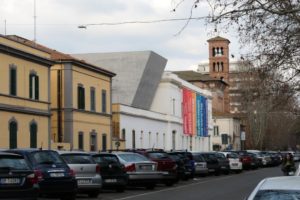
An international competition was launched in 1998 for the design of the MAXXI project, won by Anglo-Iraqi architect Zaha Hadid, chosen from among 273 candidates from all over the world. The success of her design proposal was largely due to its capacity to integrate the new project with the existing urban fabric of essentially un-prepossessing neo-classical buildings. Her scheme also incorporated parts of the former barracks/car factory, into an innovative approach to the architecture of the new complex with an extraordinary sequence of public spaces. When completed, the Museum received the Stirling Prize for Architecture from the Royal Institute of British Architects.
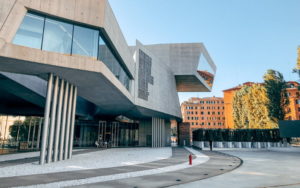
The architecture of the MAXXI is clearly that of the 21st century, and reflects the very essence of Zaha Hadid’s style of form and structure. Her vision for the museum was that there would be no boundaries, instead, an amalgamation of ideas, functions and forms. Hadid’s idea was not to isolate spaces, rather, that the building would be open and flowing, with no isolated or closed spaces, and that the different areas function as interactive spaces that draw the visitor in. This approach also makes the areas functional for moving and accommodating temporary exhibitions, with minimal fixed walls or other restrictions. With their ceiling height at 6m and plenty of natural, filtered daylight, the galleries are bright and light.

The campus of the MAXXI actually consists of two museums: ‘MAXXI Art’ and ‘MAXXI Architecture’, plus a large outdoor space surrounding the museum which provides a venue for large-scale works of art. The MAXXI is more than just a new museum. It has grandeur and elegance, a complexity of volumes, curved walls, variations in the levels, and yet a totally functional configuration to address the different uses to which the complex will be used.
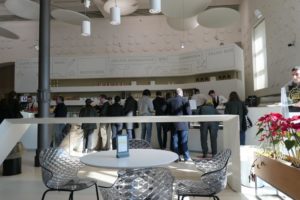
The large, full height atrium houses the bright and airy reception area, and this space leads towards an auditorium, the galleries housing the permanent collections, and to the temporary exhibition spaces, as well as spaces devoted to the cafeteria and the excellent design shop.
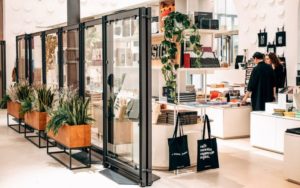
Called Booktique, this shop sells a great selection of books about architecture, design and art, but also cool bags, accessories, mugs, posters and more. There is also a media library dedicated to art and architecture. The whole plan enables the visitor to move seamlessly from one space to another, with ramps in open spaces that invites the visitor to walk through the spaces and comfortably progress from one level to another as they circulate through the building.
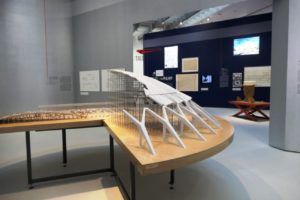
The museum offers a diversity of exhibitions throughout the year. Currently, some of these include an exhibition called ‘Architetture, a Regola d’Art’ (Architecture, a Rule of Art) through archival documents, images and correspondence about projects from some of the most important Italian architects of the 20th century, emphasising the relationship between architecture and art in their work.
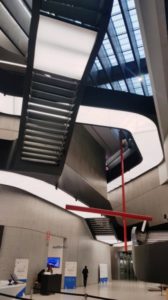
Another architectural exhibition is ‘Time Regained: Stories of Jewish Architects’, consisting of archive documents, drafts and testimonies of nine architects whose lives and careers were interrupted by racial laws promulgated on 14 July 1938. The aim was to curtail the activities of Jewish professionals, including a number of architects whose projects were either taken away from them and assigned to others, or cancelled entirely. The exhibition is part of a project ‘Architecture and Remembrance: the discrimination of Architects in Nazi-Fascist Regimes’.
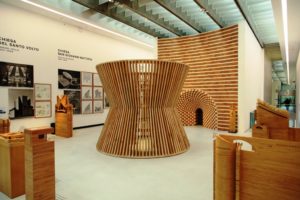
There are numerous art exhibitions, such as ‘What a Wonderful World’, described as an innovative itinerary that brings together major installations by 15 international artists, including key works from the Museum’s own collection and others commissioned especially for the exhibition.
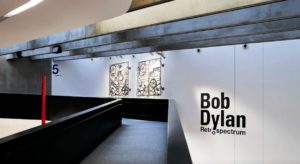
Another important art exhibition, which finished at the end of April this year, was ‘Bob Dylan: Retrospectrum’, which marked Dylan’s life-long journey of creating visual art, emphasising themes of his personal journeys and geographies. The multifaceted nature of Bob Dylan was explored through a wide range of his artworks ranging from oil paintings, acrylics, watercolours, ink drawings and a series of iron sculptures, all demonstrating how his work evolves constantly in exciting new ways. It was the first European exhibition to explore Dylan’s extraordinarily wide visual oeuvre.

During the year there has also been a fascinating exhibition on the life and work of the Italian filmmaker, poet and one of the great intellectuals and creators of the 20th century, Pier Paolo Pasolini, to mark the centenary of his birth. The exhibition is titled ‘Tutto è Santo’ (‘Everything is Holy’), focussing on the issues of public life and Pasolini’s acute observation of power dynamics that have made him something of a protester and prophet, commenting on the disappearance of the suburbs, the effects of massive media consumption on the general public and disruptive forces at work in society. His work is interpreted through the voices of contemporary artists whose own works evoke Pasolini’s political commitment and analysis of society.
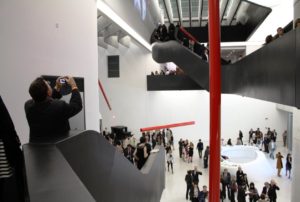
The MAXXI is located in the Flaminio quarter, in the northern part of Rome. Even though it’s perhaps a little-known sector of the city, it’s very easy and convenient to get to by bus including the 53, 168, 280 and the 910, as well as one called the Museum Express, whose terminus is the MAXXI. Ask the bus driver to indicate where to get off—they all know it.
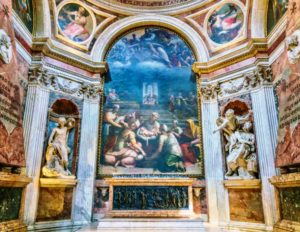
Tram Line C from the traffic plaza beyond the Piazza del Popolo is also an easy ride. While here, take the opportunity to pop into the Basilica de Santa Maria del Popolo and have a look at the Chigi Chapel designed by Raphael.
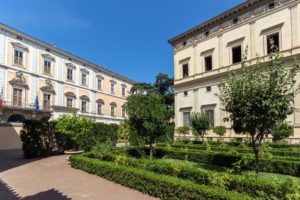
Together with the Villa Farnesina, the MAXXI is a fascinating, and unique addition to the city of Rome, where one typically thinks of the great monuments of antiquity, and wonderful galleries such as the Villa Borghese or Capitoline. Add both these great art museums to give a new, fresh dimension your enjoyment of the Eternal City.
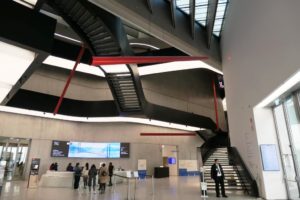


Leave a Reply